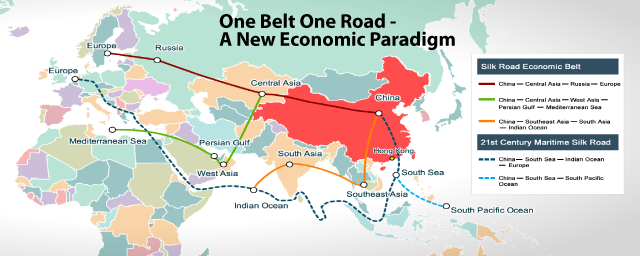In 2013, China announced the One Belt One Road initiative. A global infrastructure development strategy, the Belt and Roads initiative connects Africa, Asia, and Europe, stimulating investment in infrastructure as well as the local economies of the countries involved. Touted as a stimulus package for a slowing economy, there are some concerns that this could be interpreted as a form of Chinese economic imperialism. Such anxieties are especially present in smaller, low and middle income countries. But in a world fighting climate change and striving for sustainability, what is the environmental impact of the Belt and Road Initiative?

What is the Belt and Road Initiative?
Made up of a ‘belt’ of overland corridors and a maritime ‘road’ of shipping lanes, the Belt and Road Initiative (BRI) is a trillion dollar initiative comprised of investments in communication, transportation and energy networks across Asia, Oceania and Africa.
This investment and development of infrastructure includes:
- railways
- roads
- ports
- energy systems
- communication networks
However, development on such a massive scale also raises serious concerns over potential environmental impacts.
Environmental Impacts of the Belt and Road Initiative
Ecological Threats
Many of the BRI’s corridors cut through ecologically sensitive areas. As a result, these corridors threaten fauna and flora, along with the livelihoods of the people that live there.
Hydropower projects along the Mekong River have resulted in changes to fish migration and river flow, which directly affects the lives of the local communities. The creation of the Pan Borneo Highway– which spans Malaysia, Indonesia and Brunei– has led to deforestation, loss of biodiversity, landslides and floods. According to the WWF there are over 1700 critical biodiversity spots and 265 threatened species that will be adversely affected by the BRI.
In addition to the loss of habitat, the invasion of alien species pose a further threat. Moreover, the introduction of non-native amphibians, reptiles, birds and mammals could badly impact ecosystems and agricultural exports.
Exporting Energy
China is the leading emitter of greenhouse gases. While it has become a major investor in green technologies, there are concerns that it will use the BRI to export its fossil fuel-based economy to participating countries. Lower and middle income countries, typically those which are energy hungry, could become dependent on low efficiency coal technology. This would be sold cheaply by Chinese companies that now have to adhere to stricter emission standards domestically. By the end of 2016, China was involved in 240 coal projects in countries forming part of the BRI.
One big mistake? Maybe not.
Most of the countries involved in the BRI are lower and middle income nations. The economic benefits of improved transportation, energy production and trade in these countries are plentiful. In addition, the potentially negative environmental impacts of these developments can be mitigated by considering the environmental aspects during the planning, building and operating of infrastructure.
The construction of a hydropower plant on the island of Sumatra has been delayed until at least 2025 largely because funding has stopped due to environmental concerns. The site is located in the only known habitat of the endangered Tapanuli Orangutan. Funding for the project remains uncertain as a result of this. It is encouraging that the main funder, The Bank of China, has promised a review in light of environmental concerns.

While China is involved in a large number of coal projects it is also the leading producer of renewable energy products. This provides China with the opportunity to promote norms of renewable energy in BRI countries and to secure new markets.
China-Singapore Eco-City Tianjin
China’s first green development demonstration zone is currently being developed as a model for other eco-cities in China. A joint development with Singapore, the project includes sustainable homes for 350 000 people. It will make use of solar and wind power, waste water treatment and sea water desalination in an attempt to reduce carbon footprints.

The Belt Road Initiative clearly has great potential, not only for China, but for all of the countries involved. But efforts to maintain a balance between development and environmental protection need to be ongoing. While economic and social progress is important, is is equally important that this advancement doesn’t cause irreversible damage to our planet.
At THRIVE we value a holistic approach to sustainability. Find out more by checking our platform to see how we can achieve a THRIVEable future for us all.























